What Is an HRIS? A Complete Guide to Human Resource Information Systems
Unlock HRIS benefits! Enhance HR with data management, payroll automation, & analytics. Compare systems & choose your solution now!
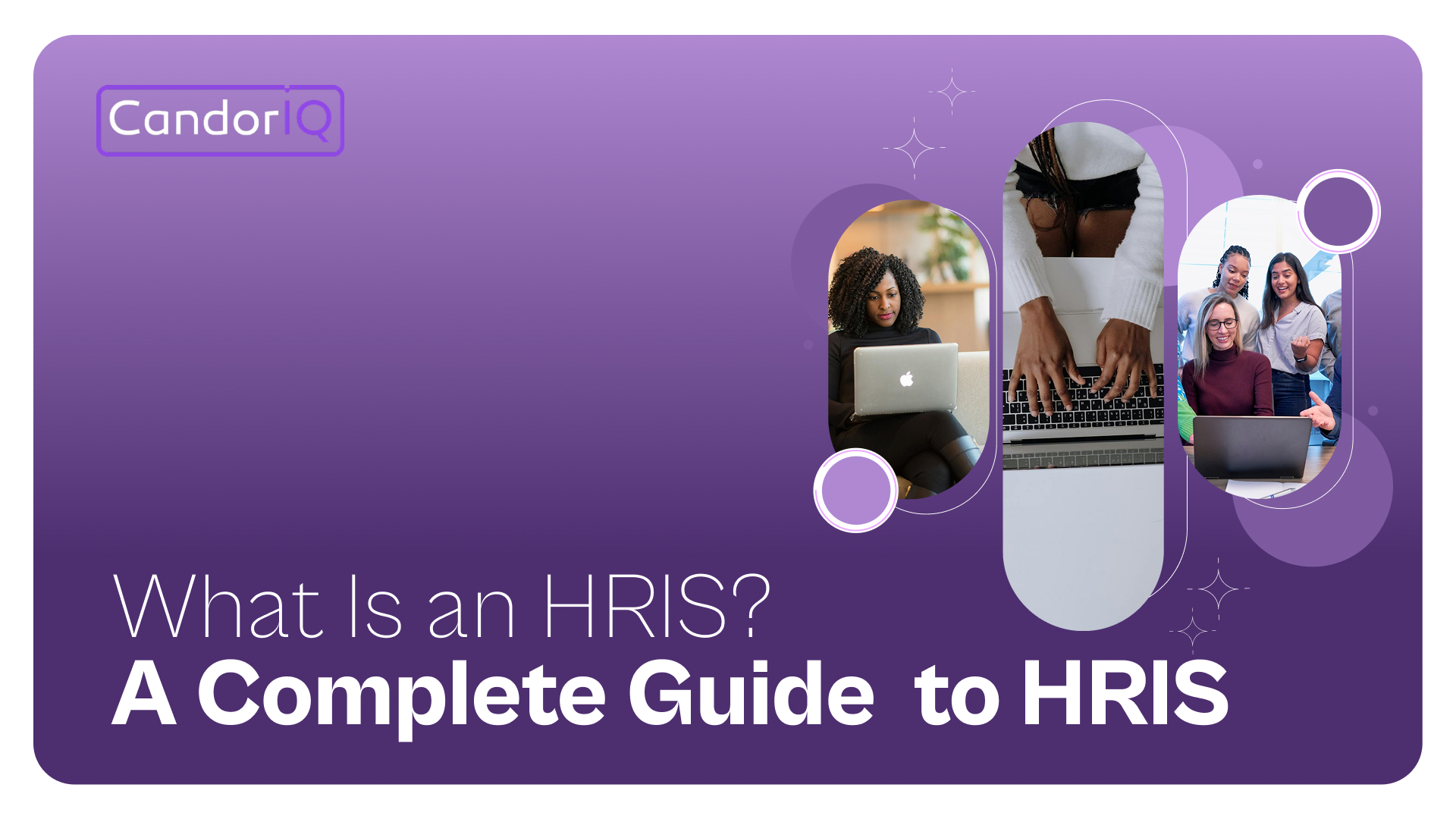
A Human Resource Information System (HRIS) is a digital solution that centralises employee information and automates core HR functions such as payroll, benefits and workforce data management.
Think of it as the system of record for all people-related information within an organization. Instead of relying on spreadsheets or disconnected tools, an HRIS serves as a single and secure hub where HR teams can store, update and even retrieve employee data in real time.
A well-structured HRIS improves accuracy, reduces administrative workload and ensures compliance with labour and data privacy regulations. For growing companies, it lays the foundation for scalable HR operations by standardising processes and minimising manual intervention.
In short, an HRIS answers the “how” behind modern HR efficiency. It simplifies the process of how companies keep employee data organised, consistent and accessible across departments.
Key Takeaways
- A Human Resource Information System centralises employee data and automates key HR functions like payroll, benefits and compliance.
- Modern HRIS platforms provide analytics and insights that drive smarter workforce and compensation decisions.
- Emerging systems use AI to predict attrition, model headcount costs and recommend equitable pay adjustments.
- HRIS bridges HR and Finance, enabling unified, data-driven planning and budget control.
- CandorIQ integrates the compensation planning, workforce forecasting and AI-powered insights, turning HR data into real-time strategy.
Understanding HRIS: The Backbone of Modern HR
While traditional HRIS platforms focused on record-keeping, modern systems go far beyond that. Today’s HRIS solutions have evolved into strategic enablers that drive collaboration, analytics and organizational alignment.
An HRIS no longer stores data; it transforms it into insight. By connecting data points across payroll, performance, compensation and workforce planning, the HR leaders gain a complete picture of their people's operations.
This in-depth visibility empowers HR and Finance teams to make proactive, evidence-based decisions, whether it’s forecasting headcount, modeling budgets or identifying pay inequities.
For fast-growing organizations, an HRIS serves as the bridge between administrative efficiency and strategic impact. It ensures that every hiring, promotion and compensation decision aligns with company goals, fostering both agility and accountability.
Core Functions and Business Impact of an HRIS
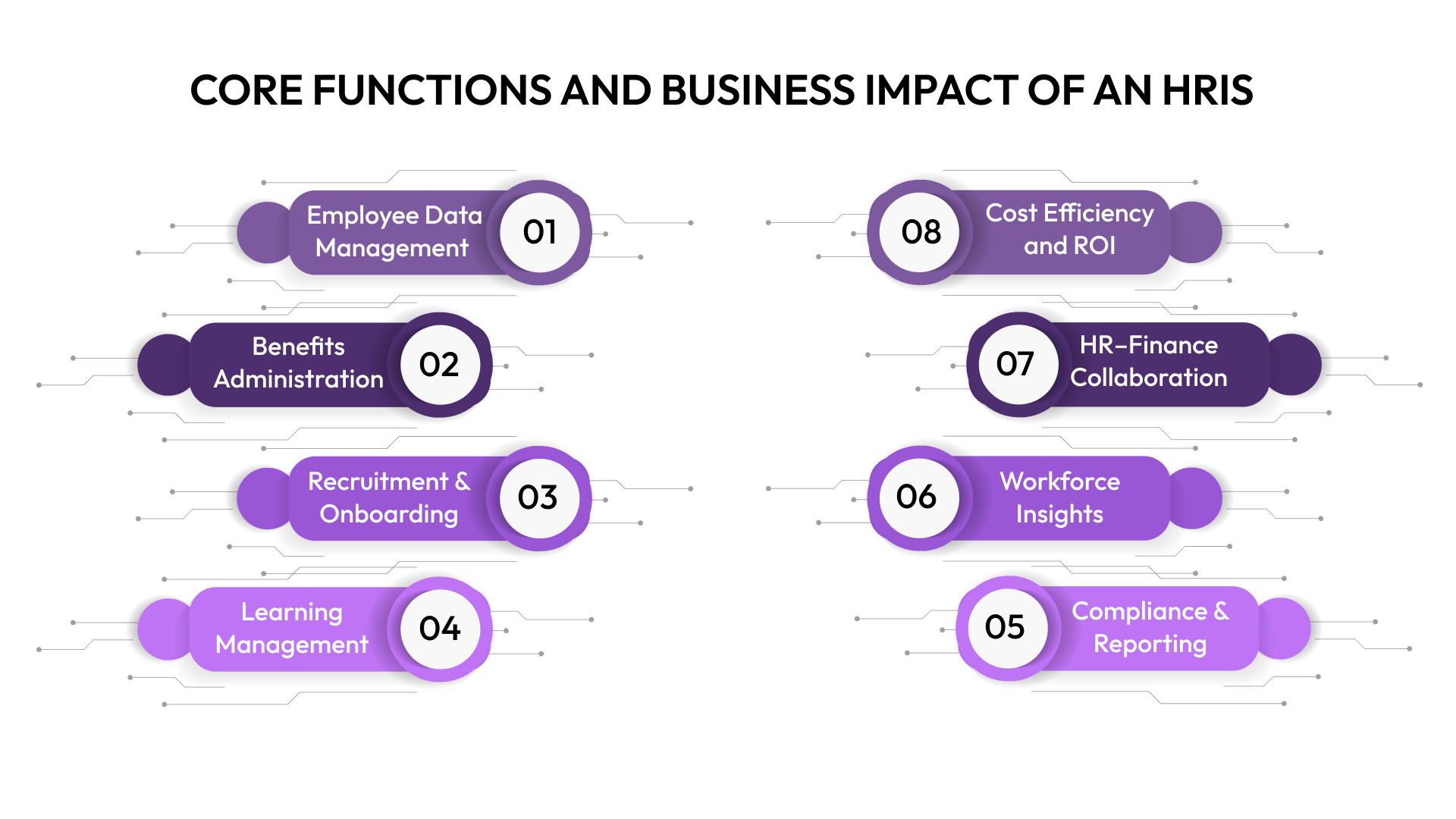
For growing organizations, the impact of an HRIS is best seen in its core operations. From hiring and payroll to analytics and compliance, each function helps HR and Finance move faster, reduce risk, and make every people decision data-driven.
Below are the core functions of an HRIS and the business impact each creates.
1. Employee Data Management
An HRIS serves as a single source of truth for employee records, storing personal details, compensation history, job changes, and compliance documents in one place.
Centralized data eliminates errors, improves consistency across HR and Finance, and provides real-time visibility into workforce composition. This ensures decisions are based on accurate, up-to-date information, not scattered spreadsheets.
2. Payroll and Benefits Administration
HRIS software automates payroll processing, deductions, and benefits administration. It integrates with providers such as healthcare and retirement plans to ensure entitlements are managed accurately and on time.
Automation reduces manual effort, minimizes compliance risks, and prevents costly payroll errors. HR teams gain more time to focus on strategic work such as retention planning and performance optimization.
3. Recruitment and Onboarding
An HRIS streamlines recruitment by tracking applicants, managing job postings, and transitioning successful candidates into onboarding workflows.
Automated onboarding ensures new hires receive credentials, training, and benefits setup immediately, improving the employee experience and maintaining consistency across teams as the organization scales.
4. Performance and Learning Management
HRIS platforms connect performance reviews, feedback loops, and learning programs in one system. Managers can set goals, track progress, and align evaluations with organizational objectives.
Linking performance data to compensation and promotions builds transparency and accountability. Employees understand how their contributions affect growth opportunities, fostering engagement and motivation.
5. Compliance and Reporting
Modern HRIS tools automatically track compliance with labor laws, tax requirements, and data protection standards such as GDPR and CCPA.
Automated compliance reduces exposure to penalties and simplifies audits through up-to-date, audit-ready reports. For global teams, it ensures consistent policy adherence across regions.
6. Analytics and Workforce Insights
Built-in analytics dashboards allow HR and Finance leaders to monitor trends in headcount, turnover, compensation, and productivity, all in real time.
These insights transform HR data into actionable intelligence. Teams can forecast workforce needs, model budgets, and identify risks before they escalate, turning HR from an administrative function into a strategic business partner.
7. Collaboration Between HR and Finance
A well-integrated HRIS aligns HR data with financial systems, ensuring both teams work from a single, accurate dataset.
This collaboration brings transparency to headcount and payroll budgets, speeds up approvals, and helps leadership balance workforce investments with overall business goals.
8. Cost Efficiency and ROI
By reducing manual tasks, consolidating multiple tools, and improving accuracy, an HRIS directly lowers operational costs.
Organizations that leverage HRIS automation see measurable ROI through reduced errors, faster cycles, and optimized workforce spend, helping HR prove its value as a revenue-conscious partner.
A robust HRIS does more than streamline HR processes; it drives measurable business value. Uniting automation, analytics, and collaboration, it helps HR and Finance teams make faster, fairer, and more informed workforce decisions.
In today’s data-driven environment, HRIS platforms have become strategic engines for growth, compliance, and people success.

HRIS vs HRMS vs HCM: Key Differences Explained
The world of HR software is full of acronyms: HRIS, HRMS, and HCM, often used interchangeably. But while they share similarities, each serves a different depth of purpose within the HR tech stack.
Understanding these distinctions is essential for selecting the right system for your organization’s needs.
1. HRIS (Human Resource Information System): The Foundation
An HRIS is primarily designed to manage employee data and core HR operations.
It focuses on the administrative backbone of payroll, benefits, compliance, time tracking and record management.
Think of HRIS as your organization’s digital filing cabinet, which is structured, reliable and essential for maintaining consistency and compliance.
For growing companies, HRIS software is often the first step toward replacing spreadsheets and establishing a single source of truth for employee data.
2. HRMS (Human Resource Management System): The Functional Upgrade
An HRMS expands on HRIS capabilities by adding modules that support the entire employee lifecycle from recruitment and onboarding to performance and learning management.
It brings people management closer to strategy by helping HR teams link employee performance with organizational goals.
In short, while HRIS answers “What’s happening in HR?”, HRMS answers “How are we managing and improving it?”
HRMS systems often include workflow automation, approval routing, and integrations that support mid- to large-sized organizations managing complex teams.
3. HCM (Human Capital Management): The Strategic Layer
HCM represents the most comprehensive evolution of HR technology, moving beyond management to strategic enablement.
HCM platforms focus on optimising the value of human capital through analytics, forecasting, succession planning and workforce modeling. They enable leadership to align talent strategy with overall business goals.
HCM isn’t just about tracking employees; it’s about understanding how people drive performance, growth, and innovation.
Comparing HRIS, HRMS, and HCM at a Glance
How These Systems Interconnect
Rather than viewing HRIS, HRMS, and HCM as competitors, it’s better to think of them as layers of evolution:
- HRIS → establishes structure and compliance
- HRMS → improves process efficiency
- HCM → drives strategic insights
Modern platforms like CandorIQ combine elements of all three — offering the robust data management of an HRIS, the functional power of an HRMS, and the strategic intelligence of an HCM system.
As organizations grow, they need more than static data storage; they need actionable intelligence.
The next evolution in HRIS is AI-driven automation that predicts, recommends and streamlines decisions across compensation and workforce planning.
Emerging Trends: AI and Automation in HRIS
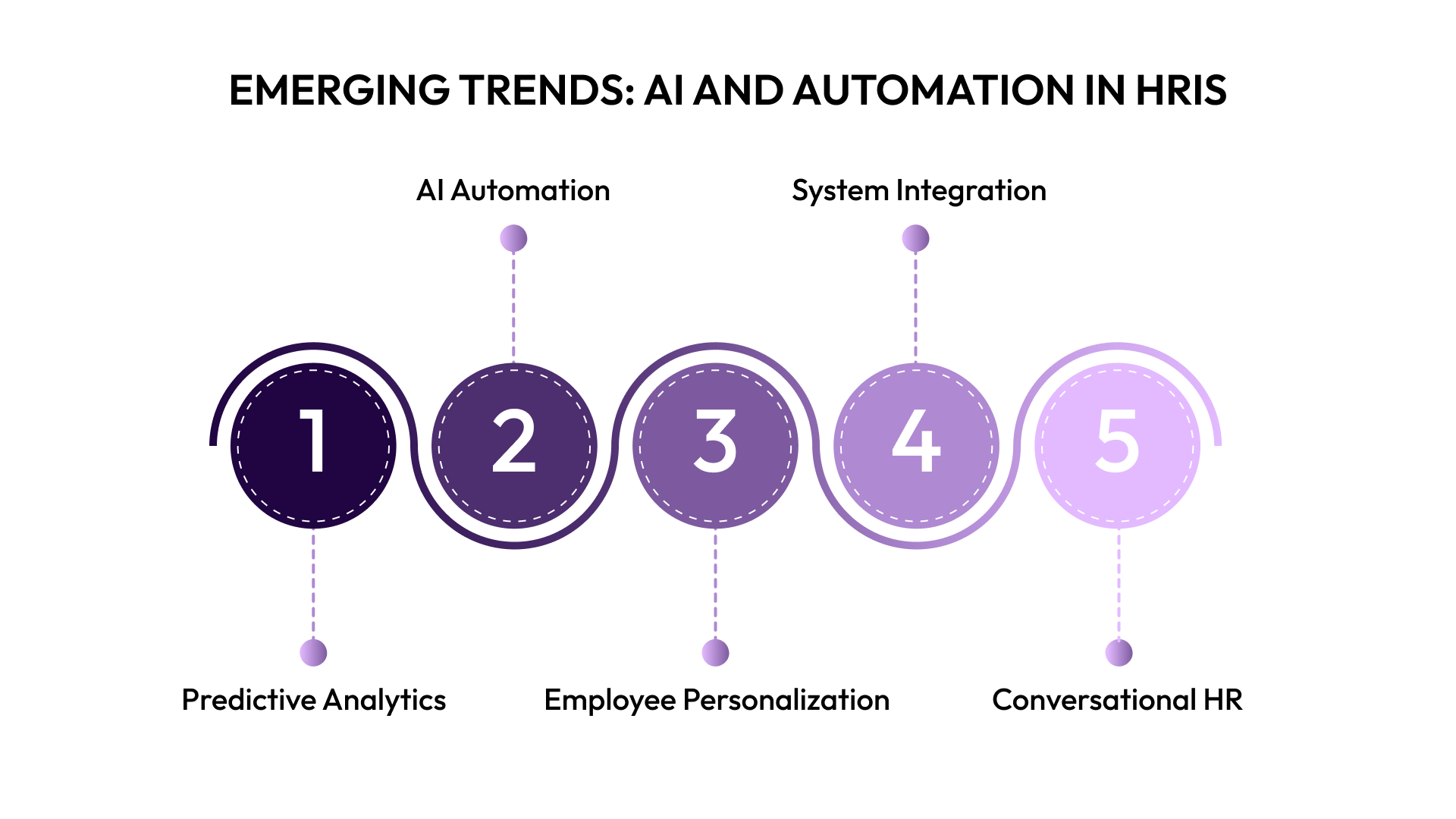
HR systems are no longer just digital filing cabinets; they’ve become intelligent ecosystems that guide decision-making.
As technology evolves, HRIS platforms are incorporating artificial intelligence (AI), machine learning (ML), and predictive analytics to transform how HR and Finance teams operate.
Here’s how modern HRIS solutions are redefining what’s possible in workforce management.
1. Predictive Analytics for Smarter Decision-Making
AI-powered HRIS platforms analyse large volumes of workforce data to uncover trends, forecast needs, and highlight risks before they become problems.
Instead of looking backwards at static reports, leaders can now answer forward-looking questions like:
- Which roles are most at risk of turnover?
- Where are compensation gaps emerging?
- How will next quarter’s hiring impact our burn rate?
These predictive insights enable HR and Finance to act proactively, adjusting budgets, compensation or hiring strategies in real time.
For scaling companies, this capability turns workforce planning from reactive firefighting into confident forecasting.
2. AI-Powered Automation
AI-driven automation is simplifying time-consuming HR tasks, from resume screening to headcount approvals.
With intelligent workflows, HR teams can automate recurring actions (like salary updates or cycle approvals) while ensuring proper oversight through pre-set rules.
In compensation management, AI can automatically flag pay inequities, recommend merit increases, or benchmark salaries against real-time market data.
This not only speeds up HR cycles but also enforces fairness and consistency in decision-making.
3. Personalized Employee Experiences
AI-enabled HRIS tools can also tailor the employee experience.
From personalized learning recommendations to adaptive benefits programs, automation helps employees access the information and tools most relevant to them.
This kind of personalization boosts engagement, reduces attrition, and helps organizations meet employee expectations for flexibility and transparency.
Employees don’t just want information; they want insight. Modern HRIS systems deliver both, instantly.
4. Integration with Finance and Business Systems
AI-driven HRIS solutions increasingly integrate with financial and business analytics tools to align workforce data with financial performance.
This unified visibility allows leadership to understand how people decisions impact profitability, cash flow, and long-term growth.
By bridging HR and Finance, companies can optimize workforce spend and forecast more accurately, a critical advantage in volatile market conditions.
5. The Rise of Conversational AI in HR
A new wave of innovation involves AI agents and chat-based assistants embedded within HRIS platforms.
These agents allow HR and Finance professionals to ask natural language questions like:
“What’s our current headcount by department?”
“Which teams have the highest compensation variance?”
“Show me forecasted hiring costs for next quarter.”
Instead of navigating complex dashboards, leaders get instant, data-driven answers — accelerating analysis and improving decision quality.
AI and automation are redefining what HRIS can achieve, turning systems of record into systems of intelligence.
How an HRIS Powers Compensation and Headcount Planning
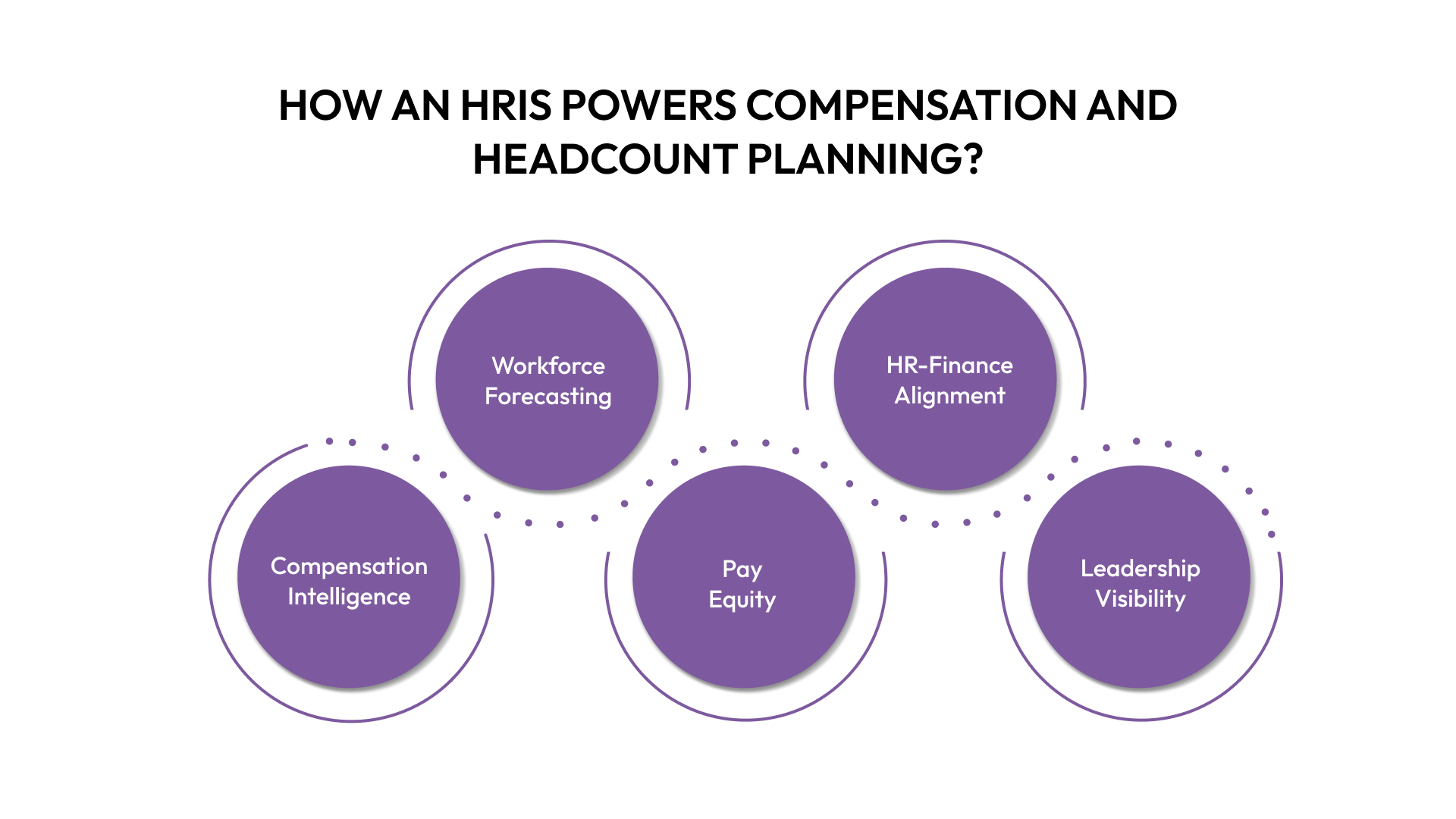
While many companies adopt HRIS software to centralize data and automate workflows, the real business value lies in how that information is used.
A modern HRIS doesn’t just record employee information; it provides the data foundation that powers strategic compensation and headcount decisions.
When integrated with analytics and planning tools, HRIS data becomes a bridge between HR and Finance, aligning people investments with financial strategy.
1. Turning Employee Data Into Compensation Intelligence
Your HRIS contains some of the most valuable data in your organization, salary history, job levels, tenure, and performance ratings. When structured and analyzed correctly, this data can reveal pay gaps, internal equity issues, and opportunities to adjust compensation for retention or fairness.
With AI-enabled systems, HR teams can move beyond static pay bands to dynamic compensation modeling, adjusting offers and raises based on benchmarks, geography, and budget scenarios in real time.
For example, HR leaders can instantly visualize how merit increases or market corrections will impact total payroll cost, all before executing a compensation cycle.
2. Forecasting Headcount and Workforce Costs
HRIS platforms play a crucial role in headcount planning and forecasting.
By tracking active employees, open roles, and planned hires, HR and Finance can model future workforce scenarios, projecting costs, productivity, and burn rate.
This visibility helps answer critical questions like:
- How many hires can we make within the current budget?
- What’s the financial impact of delaying or accelerating recruitment?
- Which departments are over or under budget based on real-time headcount data?
The result: fewer surprises at quarter-end and a more predictable view of workforce spending.
3. Enabling Pay Transparency and Equity
An HRIS also helps organizations advance pay transparency and equity initiatives by providing data-driven visibility into compensation distribution.
HR leaders can ensure consistency in pay bands across teams, track demographic or regional differentials, and document how compensation aligns with internal policies and DEI commitments.
This transparency not only builds trust among employees but also strengthens compliance with evolving pay equity regulations across the U.S.
Data-backed fairness isn’t just good ethics; it’s good business, improving retention and brand reputation.
4. Aligning HR and Finance Through Data
For most organizations, compensation is the single largest expense.
Integrating HRIS data with financial planning systems allows HR and Finance teams to work from the same set of facts, enabling joint accountability for headcount, budgeting, and forecasting.
This integration ensures that:
- Raises and hiring plans stay within approved budgets.
- Finance gains visibility into future payroll obligations.
- HR can proactively manage workforce costs without sacrificing fairness or agility.
In short, an effective HRIS transforms compensation planning from a spreadsheet exercise into a strategic forecasting process.
5. Empowering Leadership With Real-Time Visibility
Executives and managers need a clear, up-to-date view of workforce metrics — not once a quarter, but continuously.
Modern HRIS dashboards combine real-time headcount data, compensation analytics, and turnover trends to give leadership instant clarity on workforce health.
This level of visibility supports faster decision-making, improves cross-departmental alignment, and ensures that workforce planning always ties back to business objectives.
A data-driven HRIS provides a foundation for fairness, foresight, and financial control; however, selecting the right one depends on your organization’s size, complexity, and growth stage.
Choosing the Right HRIS for Your Organization
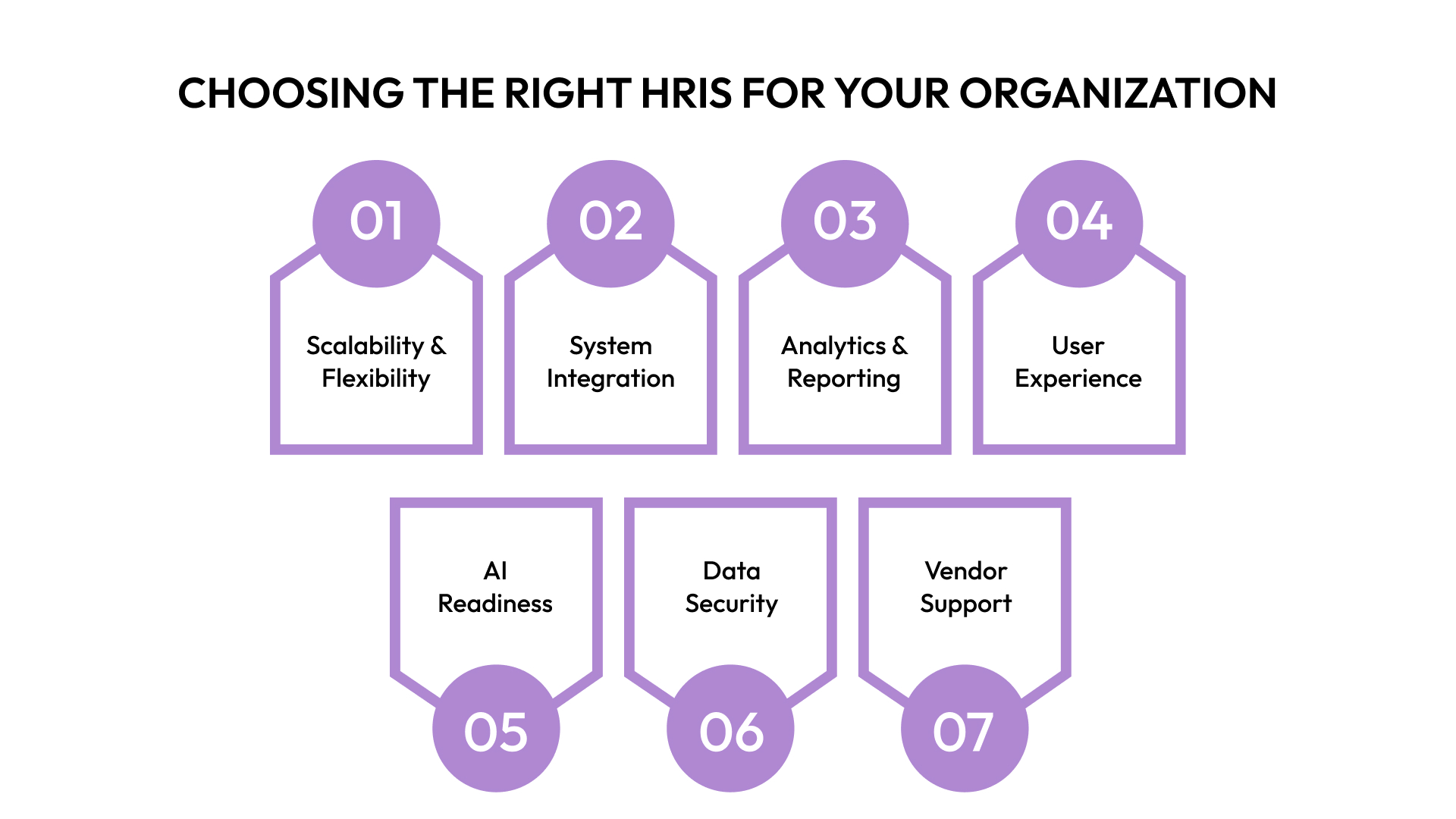
Selecting the right HRIS is one of the most strategic investments an organization can make.
The ideal system not only automates administrative work but also acts as a central intelligence hub, connecting HR, Finance and leadership.
However, with dozens of solutions in the market, from legacy enterprise systems to agile AI-powered platforms, choosing the right HRIS depends on your company’s size, complexity, and growth trajectory.
Here’s a practical framework to guide your decision.
1. Scalability and Flexibility
A good HRIS should grow with your organization.
If you’re planning to scale headcount or expand into new regions, the platform must handle multi-location payrolls, diverse pay bands, and role hierarchies without friction.
Look for flexible configuration options that allow you to adapt workflows, access permissions, and reporting structures as your team evolves.
For fast-growth companies, scalability isn’t optional; it’s the difference between a short-term fix and a long-term solution.
2. Integration With Existing Systems
Your HRIS shouldn’t operate in isolation.
To get full value, it must integrate seamlessly with your existing tools, including your applicant tracking system (ATS), payroll software, HRIS data feeds, and financial planning tools.
This interconnected ecosystem ensures smooth data flow and eliminates redundant entries across systems.
For example, when a candidate is hired through the ATS, the HRIS should automatically create their employee profile, trigger onboarding, and sync salary data with Finance.
3. Analytics and Reporting Capabilities
The most powerful HRIS platforms don’t just store data; they help you interpret it.
Look for advanced reporting and analytics features that provide visibility into headcount, compensation, attrition, and performance trends.
Predictive analytics can even help you anticipate workforce needs and budget requirements before issues arise.
In today’s environment, data-driven visibility is no longer a nice-to-have — it’s essential for proactive decision-making.
4. User Experience and Accessibility
An HRIS only succeeds if people actually use it.
Both HR administrators and employees should find the system intuitive and accessible from anywhere.
Modern, cloud-based HRIS platforms should include employee self-service (ESS) and manager self-service (MSS) portals that simplify everyday actions like updating personal data, requesting time off, or viewing compensation information.
A clean, intuitive interface reduces training time, boosts adoption, and ensures consistent data entry across the organization.
5. AI and Automation Readiness
The next generation of HRIS tools is powered by AI.
Choosing a platform that supports automation from compensation recommendations to headcount forecasting ensures your organization stays competitive as HR tech evolves.
AI capabilities should include predictive modeling, data validation, and automated workflows that reduce human effort while maintaining control and transparency.
Look for platforms that blend automation with oversight, allowing HR and Finance leaders to make smarter, faster, and fairer decisions.
6. Data Security and Compliance
Your HRIS stores sensitive employee data, from payroll to performance reviews.
Robust security and compliance features are non-negotiable.
Ensure the system complies with standards like GDPR, CCPA, and SOC 2, and that it includes encryption, access controls, and audit logs.
With increasing data privacy scrutiny, a secure HRIS protects not just your employees’ information but also your organization’s reputation.
7. Vendor Support and Implementation Expertise
Even the best software can fall short without the right onboarding and support.
Evaluate vendors based on their implementation process, customer service responsiveness, and ability to provide hands-on training.
Bonus points for vendors that offer dedicated onboarding specialists and post-launch optimization support, essential for smaller HR teams with limited technical bandwidth.
The right HRIS doesn’t just digitize your HR operations; it amplifies them.
And while most systems stop at data management, some go further by unifying compensation, headcount, and workforce strategy under one intelligent platform. Let us see how CandorIQ builds on HRIS capabilities to deliver a connected, AI-driven people operations experience.
CandorIQ: The Next Evolution Beyond Traditional HRIS
Traditional HRIS platforms do an excellent job of storing employee data and automating administrative tasks, but that’s where most of them stop.
Modern organizations, however, need more than automation. They need insight, alignment, and strategic foresight to make workforce decisions that balance fairness, cost, and growth.
That’s where CandorIQ stands apart.
From Record-Keeping to Strategic Enablement
CandorIQ builds on the foundational capabilities of a traditional HRIS, employee data management, payroll tracking, and headcount visibility and layers in real-time analytics, collaboration, and AI-powered decision support.
Instead of acting as a static database, CandorIQ functions as a strategic control center that connects HR and Finance teams through shared data, shared forecasts, and shared accountability.
It doesn’t just tell you what’s happening, it helps you decide what to do next.
How CandorIQ Extends the HRIS Framework
CandorIQ combines the data accuracy of an HRIS with the strategic intelligence of workforce planning and compensation platforms.
Here’s how:
- Compensation & Payband Builder: Define equitable pay structures across levels, geographies, and departments. Incorporate location-based salary adjustments using market data for fairness and consistency.
- Compensation Cycle Automation: Run merit and bonus cycles in days, not weeks, with built-in approval logic, collaboration tools, and Slack or email integrations.
- Headcount Scenario Planning: Model multiple hiring and workforce scenarios, analyze their financial impact, and align hiring plans with budget realities.
- Headcount Requests & Approvals: Standardize hiring workflows with embedded job details, rationale, and budget checkpoints, ensuring alignment between People Ops, Finance, and leadership.
- Workforce Management Dashboard: Get an instant view of open roles, filled seats, promotions, and attrition compared against your plan and budget.
- AI Agent: Ask natural-language questions, like “What’s our total compensation variance by department?” or “Where are we over budget on headcount?” The AI agent surfaces insights, forecasts, and recommendations instantly.
Why It Matters
By integrating compensation, headcount, and analytics in one system, CandorIQ eliminates the silos that slow down decision-making.
Finance no longer works from outdated spreadsheets. HR no longer spends hours reconciling data across systems.
Instead, both teams operate from the same live data, ensuring every hiring, promotion, or compensation decision supports business goals and budget limits.
CandorIQ transforms HRIS data from records into a real-time strategy.
Who It’s Built For
CandorIQ is purpose-built for mid-sized to growth-stage companies organizations scaling fast with lean HR and Finance teams.
It’s designed for leaders who want to:
- Align compensation with headcount plans and budgets.
- Build pay transparency and equity into every decision.
- Use AI to forecast workforce costs and reduce attrition risk.
- Turn people data into strategic business intelligence.
Whether your team has 50 or 5,000 employees, CandorIQ scales to your complexity, helping you move from reactive HR management to proactive, data-driven workforce planning.
The Result: Clarity, Control, and Collaboration
CandorIQ replaces spreadsheets and disconnected tools with a unified, intelligent platform that:
- Delivers transparency across HR and Finance.
- Enables real-time collaboration on compensation and headcount.
- Drives efficiency through automation and AI recommendations.
- Strengthens trust through equitable, data-backed pay decisions.
For organizations aiming to make every people decision strategic, CandorIQ represents the next step in the HRIS evolution, one where technology empowers alignment, not just administration.
In the modern world of HR, data is only as valuable as the insights it produces.
CandorIQ enables teams to act on those insights, bridging the gap between workforce planning, financial governance, and employee experience.

Final Thoughts
An HRIS is far more than a digital filing system; it’s the foundation for how modern organizations manage, analyze, and act on their people data.
By centralizing employee information, automating key processes, and delivering real-time insights, an HRIS enables HR and Finance teams to make smarter, faster, and fairer decisions.
But as workforce dynamics evolve, organizations need more than just visibility; they need intelligence.
That’s where CandorIQ bridges the gap between traditional HRIS functionality and the next generation of strategic people operations. With built-in AI, dynamic compensation modeling, and headcount forecasting, CandorIQ transforms static HR data into an actionable strategy.
It unites HR, Finance, and leadership teams around a single goal: driving growth through transparency, equity, and control.
If your organization is ready to move beyond spreadsheets and disconnected tools, it’s time to experience a smarter way to plan, pay, and perform.
Book a Demo to see how CandorIQ can help your team build a more transparent, efficient, and data-driven workforce strategy.
FAQs
1. What does an HRIS do?
An HRIS (Human Resource Information System) helps organizations manage employee data, payroll, benefits, and compliance in one centralized platform. It replaces manual, spreadsheet-driven processes with automation and accuracy.
2. How is an HRIS different from HRMS or HCM?
HRIS focuses on employee data and administrative tasks, HRMS expands into performance and recruiting, and HCM adds analytics, forecasting, and workforce planning, making it the most strategic of the three.
3. What are the key benefits of an HRIS?
An HRIS improves efficiency, ensures compliance, enhances employee experience, and enables data-driven decision-making across HR and Finance teams.
4. How can AI improve HRIS capabilities?
AI transforms HRIS from a system of record into a system of intelligence, automating workflows, predicting workforce trends, and recommending actions on compensation, hiring, and retention.
5. Why choose CandorIQ over a traditional HRIS?
CandorIQ extends HRIS functionality with integrated compensation planning, headcount forecasting, and AI analytics, empowering HR and Finance to collaborate on real-time, data-driven workforce decisions.
6. What size of company benefits most from CandorIQ?
CandorIQ is purpose-built for mid-sized to growth-stage organizations (50–5,000 employees) with lean HR and Finance teams that need transparency, speed, and strategic alignment in workforce planning.


